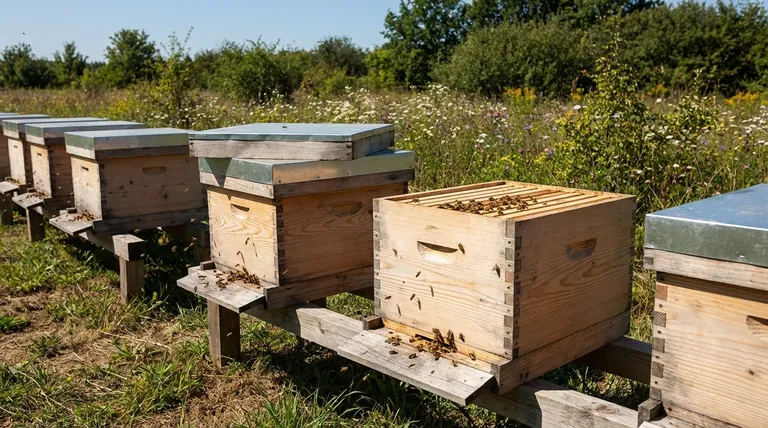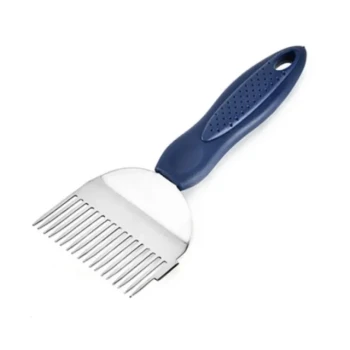In practice, beehives can be placed remarkably close together. While bees in nature might establish colonies far apart, managed apiaries can thrive with hives positioned side-by-side. The most common guideline is to provide at least two feet of clearance around each hive, a distance driven more by the beekeeper's needs and mitigating bee behavior than a strict biological requirement.
The question of hive spacing is not about finding a single "correct" distance. It is about balancing the practical need for beekeeper access against the risks of bee "drifting" and the rapid spread of problems between colonies.

The Principles Behind Hive Spacing
The "two-foot rule" is a starting point, but understanding the reasons behind it empowers you to make better decisions for your specific environment. The two primary factors are beekeeper access and bee orientation.
Ensuring Beekeeper Access
This is the most straightforward reason for spacing. You need physical room to work your hives effectively and safely.
You must be able to stand comfortably beside and behind the hive to lift heavy boxes, perform inspections, and manipulate frames without being cramped. A minimum of two feet provides this working space.
Minimizing Bee "Drifting"
"Drifting" occurs when a returning forager bee accidentally enters a neighboring hive instead of its own.
This is common when multiple hives are placed in a straight line with identical appearances. The hives on the ends tend to lose bees to the hives in the middle, creating population imbalances.
Drifting can weaken one colony while artificially boosting another, and more critically, it is a primary vector for transferring pests and diseases, like Varroa mites, from one hive to another.
Preventing Robbing Behavior
When hives are extremely close, a strong colony can more easily identify and overwhelm a weaker neighbor to steal its honey stores.
While spacing alone won't stop a determined robbing attempt, it makes it less likely for bees to casually discover the weakness of an adjacent hive during their normal comings and goings.
Understanding the Trade-offs
There is no single perfect layout; each approach has distinct advantages and disadvantages. Your choice impacts both your workflow and the health of your bees.
The Benefit of Close Placement
Placing hives in a row, 2-3 feet apart, is highly space-efficient. This is often the only practical option for beekeepers in suburban or urban backyards with limited room.
This configuration can also make some management tasks, such as equalizing colony strength by moving a frame of brood, quicker and easier.
The Risk of Proximity
The primary danger of close placement is the speed at which problems can spread. An undetected disease or a sudden mite infestation in one hive can rapidly cascade through the entire apiary.
A single, closely packed apiary functions like a monoculture. It lacks the "firebreaks" that more dispersed placements provide, increasing the risk of catastrophic loss.
Mimicking a Natural Layout
In nature, wild honey bee colonies are often separated by considerable distances. Spreading your hives out in small groups of two to four, with 10-15 feet between each group, better mimics this pattern.
This layout dramatically reduces drifting and slows the spread of disease. It also encourages bees to forage in slightly different areas, reducing direct competition.
How to Choose Your Hive Layout
The ideal configuration depends entirely on your available space, the number of hives you manage, and your primary goals as a beekeeper.
- If your primary focus is space efficiency in a small yard: Place hives side-by-side with 2-3 feet of clearance, but use different colors or symbols on the hive bodies to give bees distinct visual cues for orientation.
- If your primary focus is hive health and disease prevention: Arrange hives in small, separate groups of 2-4, with at least 10 feet separating each group to create effective firebreaks.
- If you are a new beekeeper starting with two hives: A side-by-side placement 3-5 feet apart is a perfect balance of convenience and health management for your first season.
Ultimately, thoughtful placement is a simple but powerful tool for maintaining a healthy and productive apiary.
Summary Table:
| Layout Type | Spacing | Pros | Cons |
|---|---|---|---|
| Space-Efficient (Side-by-Side) | 2-3 feet apart | Maximizes use of small areas; convenient for management. | High risk of bee drifting and rapid disease spread. |
| Health-Focused (Grouped) | 10-15 feet between groups | Mimics natural spacing; reduces drifting; acts as a disease firebreak. | Requires more land; less convenient for frequent inspections. |
| Beginner-Friendly (Two Hives) | 3-5 feet apart | Good balance of convenience and health management for new beekeepers. | Limited scalability for larger apiaries. |
Ready to build a healthier, more productive apiary?
As HONESTBEE, we supply commercial apiaries and beekeeping equipment distributors with the durable, high-quality supplies needed for optimal hive management. Whether you're planning a new layout or scaling your operations, our wholesale-focused team can provide the equipment and expertise to support your success.
Contact our experts today to discuss your specific needs and get a quote on bulk supplies.
Visual Guide

Related Products
- Wholesales Dadant Size Wooden Bee Hives for Beekeeping
- HONESTBEE Professional Long Handled Hive Tool with Precision Cutting Blade
- Professional Multi-Function Stainless Steel Hive Tool
- Professional Dual-End Stainless Steel Hive Tool for Beekeeping
- HONESTBEE Advanced Ergonomic Stainless Steel Hive Tool for Beekeeping
People Also Ask
- What types of products are available for beekeeping needs? Essential Equipment for Apiaries & Distributors
- What should beginners consider when purchasing beekeeping equipment? A Guide to Essential Starter Gear
- Why were wooden hives traditionally preferred? For Natural Beekeeping Aligned with Bee Biology
- What are the essential pieces of equipment for most beekeepers? Get Started with the Right Gear
- What are the characteristics of oil-based paint for beehives? Durability vs. Modern Practicality



















